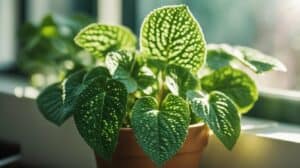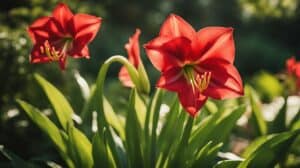Prayer plants, also known as Maranta leuconeura, are popular houseplants that are loved for their unique foliage and easy-to-care-for nature.
These plants are native to the tropical regions of Central and South America and are known for their striking leaves that fold up at night, giving them their common name of “prayer plant.”

In this comprehensive guide, you will learn everything you need to know about caring for your Maranta leuconeura.
From the ideal growing conditions to watering and fertilizing tips, this guide will provide you with all the information you need to keep your prayer plant thriving.
Whether you are a seasoned plant enthusiast or a beginner, this guide is perfect for anyone looking to add a touch of greenery to their home.
So, if you’re ready to learn how to care for your prayer plant and keep it looking its best, read on for our comprehensive guide to Maranta leuconeura care.
Getting to Know Your Prayer Plant

Species Overview
The Maranta Leuconeura, commonly known as the Prayer Plant, is a tropical plant that belongs to the Marantaceae family.
It is native to the tropical regions of Brazil, South America, and the West Indies.
The plant is named after Bartolomeo Maranta, an Italian physician and botanist from the 16th century.
History and Origin
The Prayer Plant was first introduced to Europe in the mid-19th century.
Since then, it has become a popular houseplant due to its unique foliage and easy care requirements.
The plant is known for its ability to fold its leaves upwards at night, resembling two hands in prayer, hence the name “Prayer Plant.”
Distinctive Features
The Prayer Plant is a low-growing plant that can reach up to 12 inches in height.
It has oval-shaped leaves that are dark green with striking patterns of light green veins. The underside of the leaves is a deep maroon color.
The plant produces small white flowers that are not particularly showy.
The Prayer Plant is a great choice for those who want to add some greenery to their home but don’t have a lot of natural light.
It thrives in low to medium light and prefers moist soil.
The plant is also known for its air-purifying qualities, making it a great addition to any indoor space.
Overall, the Prayer Plant is a beautiful and easy-to-care-for plant that will add a touch of tropical elegance to any home.
Essential Care Instructions
Light Requirements
The Prayer Plant, also known as Maranta Leuconeura, prefers bright, indirect light.
Direct sunlight can scorch the leaves, while too little light can cause the plant to lose its vibrant colors.
It is best to place the plant near a window that receives filtered light, or use a sheer curtain to diffuse the light.
Watering Techniques
Proper watering is crucial for the Prayer Plant’s health. The plant prefers consistently moist soil, but overwatering can lead to root rot.
It is recommended to water the plant when the top inch of soil feels dry to the touch.
Use room temperature water and ensure that the pot has drainage holes to prevent water from accumulating in the soil.
Soil and Fertilization
The Prayer Plant thrives in well-draining soil that is rich in organic matter. A mixture of peat moss, perlite, and vermiculite is ideal.
Fertilize the plant every two weeks during the growing season with a balanced, water-soluble fertilizer.
Avoid fertilizing during the winter months when the plant is dormant.
Temperature and Humidity
The Prayer Plant prefers temperatures between 65-80°F (18-27°C) and high humidity levels. Dry air can cause the plant’s leaves to brown and curl.
To increase humidity, mist the plant regularly or place a tray of water near the plant.
It is also recommended to keep the plant away from drafts and heaters.
By following these essential care instructions, you can ensure that your Prayer Plant thrives and displays its stunning foliage for years to come.
Propagation and Repotting

Propagation Methods
Prayer plants can be propagated through stem cuttings or division.
Stem cuttings should be taken from healthy, mature plants and should include at least two leaves and a node.
The cutting should be planted in a well-draining potting mix and kept in a warm, humid location until roots develop.
Division involves separating the plant into smaller sections, each with its own roots and leaves.
This can be done when repotting the plant or when the plant has grown large enough to be divided.
When and How to Repot
Prayer plants prefer to be slightly root-bound, so they do not need to be repotted often.
However, if the plant has outgrown its current pot or the soil has become compacted, it may be time to repot.
This is typically done in the spring or summer when the plant is actively growing.
To repot a prayer plant, gently remove it from its current pot and inspect the roots.
If the roots are tightly packed, gently loosen them with your fingers or a tool.
Choose a pot that is slightly larger than the current pot and has drainage holes.
Fill the bottom of the pot with a layer of well-draining potting mix and place the plant on top.
Fill in the remaining space with potting mix, making sure not to bury the stem. Water the plant thoroughly and place it in a bright, indirect location.
By following these propagation and repotting tips, you can keep your prayer plant healthy and thriving for years to come.
Troubleshooting Common Issues

Pest Management
Prayer plants are susceptible to a variety of pests, including spider mites, mealybugs, and scale insects.
These pests can cause damage to the plant and lead to stunted growth, yellowing leaves, and even death if not treated promptly.
To prevent pest infestations, it is essential to keep the plant healthy and well-watered.
If you notice any signs of infestation, such as small webs or white cottony masses on the leaves, you should take immediate action to eliminate the pests.
One effective method of pest management is to wash the plant with a mild soap solution and rinse thoroughly with water.
You can also use insecticidal soap or neem oil to control the pests.
Be sure to follow the instructions carefully and avoid using harsh chemicals that can harm the plant.
Disease Prevention
Prayer plants can also be affected by various diseases, including root rot, leaf spot, and powdery mildew.
These diseases can be caused by overwatering, poor drainage, or high humidity levels.
To prevent disease, it is important to provide the plant with proper care and maintenance.
This includes watering the plant only when the soil is dry to the touch, providing good drainage, and avoiding overfertilization.
If you notice any signs of disease, such as yellowing leaves, brown spots, or white powdery growth on the leaves, you should take immediate action to treat the problem.
This may involve removing infected leaves, improving drainage, or using a fungicide.
Leaf Problems and Solutions
One of the most common issues with prayer plants is leaf curling, which can be caused by a variety of factors, including underwatering, overwatering, low humidity, or exposure to direct sunlight.
To address leaf curling, it is important to identify the underlying cause and take appropriate action.
For example, if the plant is underwatered, you should increase watering frequency and ensure that the soil is moist but not waterlogged.
If the plant is overwatered, you should reduce watering frequency and improve drainage.
Other common leaf problems include yellowing, browning, and spotting.
These issues can be caused by a variety of factors, including nutrient deficiencies, pests, and disease.
To address leaf problems, it is important to identify the underlying cause and take appropriate action, such as providing proper fertilization or treating pests or disease.
Remember, prevention is key to maintaining a healthy and thriving prayer plant.
By providing proper care and addressing any issues promptly, you can enjoy the beauty and vitality of your plant for years to come.
Frequently Asked Questions

How should I water my Maranta leuconeura to maintain its health?
Watering a prayer plant can be a bit tricky, as overwatering can lead to root rot and under watering can cause the leaves to wilt.
It’s best to keep the soil moist but not soggy. Water your plant when the top inch of soil feels dry to the touch.
It’s also important to use room temperature water, as cold water can shock the roots.
What is the ideal lighting condition for a prayer plant indoors?
Prayer plants prefer bright, indirect light.
Direct sunlight can scorch their leaves, so it’s best to place them near a window with filtered light or in a well-lit room.
They can also tolerate low light conditions, but may not grow as quickly or produce as many leaves.
Can prayer plants thrive outdoors, or are they better as indoor plants?
Prayer plants are native to tropical regions and can thrive outdoors in warm, humid climates.
However, they are often grown as indoor plants in cooler regions.
If you live in a warm climate, you can place your prayer plant outside in a shaded area, but be sure to bring it indoors during colder months.
What type of pot is best for a prayer plant to ensure proper growth?
Prayer plants prefer well-draining soil and a pot with drainage holes to prevent water from sitting in the soil.
A pot that is slightly larger than the root ball is ideal, as it allows for room to grow.
It’s also important to choose a pot that is heavy enough to support the plant, as prayer plants can become top-heavy.
How can I tell if my prayer plant is happy and healthy?
A healthy prayer plant will have vibrant, green leaves that are slightly curled at the edges.
If the leaves are turning yellow or brown, it may be a sign of over or under watering.
If the plant is not producing new growth or the leaves are drooping, it may be a sign of insufficient light.
What are common issues with prayer plants and how can I prevent them?
Common issues with prayer plants include root rot from overwatering, pests such as spider mites and mealybugs, and leaf curling from insufficient humidity.
To prevent these issues, be sure to water your plant properly, inspect it regularly for signs of pests, and increase humidity by misting the leaves or placing a tray of water near the plant.














